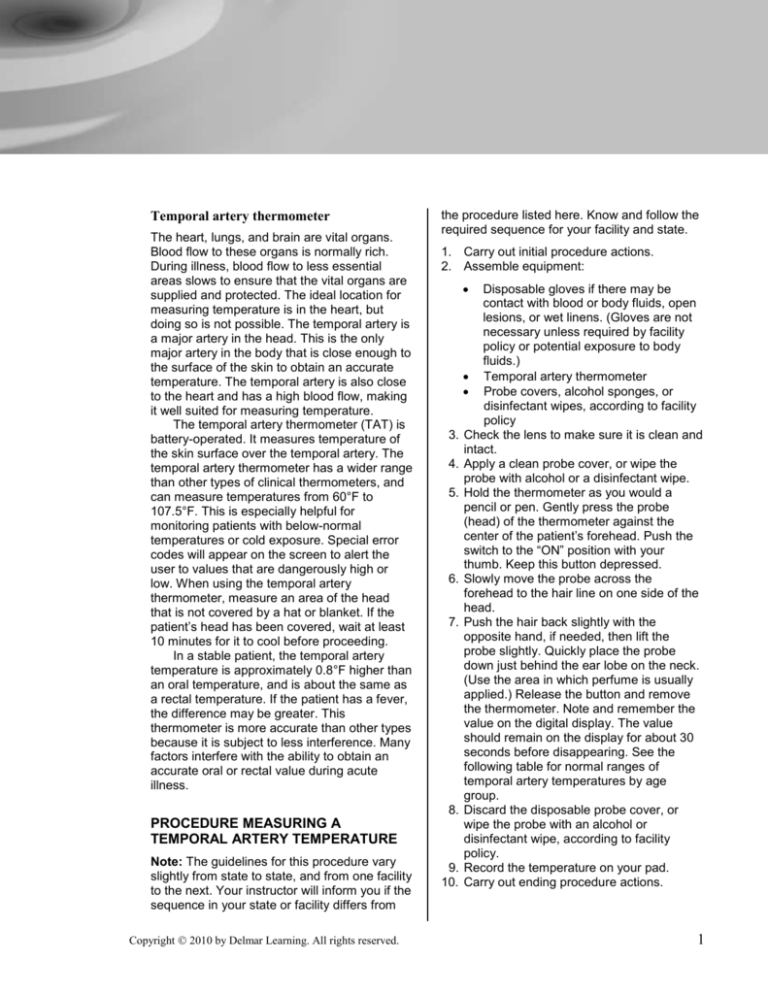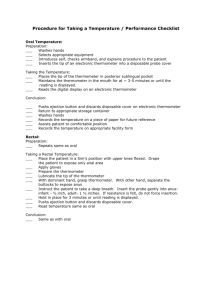
Temporal artery thermometer
The heart, lungs, and brain are vital organs.
Blood flow to these organs is normally rich.
During illness, blood flow to less essential
areas slows to ensure that the vital organs are
supplied and protected. The ideal location for
measuring temperature is in the heart, but
doing so is not possible. The temporal artery is
a major artery in the head. This is the only
major artery in the body that is close enough to
the surface of the skin to obtain an accurate
temperature. The temporal artery is also close
to the heart and has a high blood flow, making
it well suited for measuring temperature.
The temporal artery thermometer (TAT) is
battery-operated. It measures temperature of
the skin surface over the temporal artery. The
temporal artery thermometer has a wider range
than other types of clinical thermometers, and
can measure temperatures from 60°F to
107.5°F. This is especially helpful for
monitoring patients with below-normal
temperatures or cold exposure. Special error
codes will appear on the screen to alert the
user to values that are dangerously high or
low. When using the temporal artery
thermometer, measure an area of the head
that is not covered by a hat or blanket. If the
patient’s head has been covered, wait at least
10 minutes for it to cool before proceeding.
In a stable patient, the temporal artery
temperature is approximately 0.8°F higher than
an oral temperature, and is about the same as
a rectal temperature. If the patient has a fever,
the difference may be greater. This
thermometer is more accurate than other types
because it is subject to less interference. Many
factors interfere with the ability to obtain an
accurate oral or rectal value during acute
illness.
the procedure listed here. Know and follow the
required sequence for your facility and state.
1. Carry out initial procedure actions.
2. Assemble equipment:
3.
4.
5.
6.
7.
8.
PROCEDURE MEASURING A
TEMPORAL ARTERY TEMPERATURE
Note: The guidelines for this procedure vary
slightly from state to state, and from one facility
to the next. Your instructor will inform you if the
sequence in your state or facility differs from
Copyright 2010 by Delmar Learning. All rights reserved.
9.
10.
Disposable gloves if there may be
contact with blood or body fluids, open
lesions, or wet linens. (Gloves are not
necessary unless required by facility
policy or potential exposure to body
fluids.)
Temporal artery thermometer
Probe covers, alcohol sponges, or
disinfectant wipes, according to facility
policy
Check the lens to make sure it is clean and
intact.
Apply a clean probe cover, or wipe the
probe with alcohol or a disinfectant wipe.
Hold the thermometer as you would a
pencil or pen. Gently press the probe
(head) of the thermometer against the
center of the patient’s forehead. Push the
switch to the “ON” position with your
thumb. Keep this button depressed.
Slowly move the probe across the
forehead to the hair line on one side of the
head.
Push the hair back slightly with the
opposite hand, if needed, then lift the
probe slightly. Quickly place the probe
down just behind the ear lobe on the neck.
(Use the area in which perfume is usually
applied.) Release the button and remove
the thermometer. Note and remember the
value on the digital display. The value
should remain on the display for about 30
seconds before disappearing. See the
following table for normal ranges of
temporal artery temperatures by age
group.
Discard the disposable probe cover, or
wipe the probe with an alcohol or
disinfectant wipe, according to facility
policy.
Record the temperature on your pad.
Carry out ending procedure actions.
1
2
Part 5 Procedure Evaluation Forms
Table Normal Ranges for Temporal Artery
Temperatures
Age
Fahrenheit
Values
0–2 months
100.7°F
3–47 months
100.3°F
4–9 years
100.1°F
10–18 years
100.1°F
over 18 years
100.1°F
98.3°F–
98.3°F–
97.8°F–
97.4°F–
97.2°F–
Copyright 2010 by Delmar Learning. All rights reserved.










